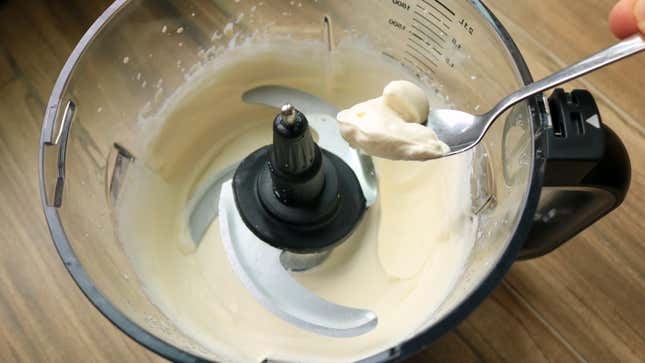Homemade whipped cream is one of my favorite dessert toppings, but it takes time to make, even in a stand mixer. Of course, it takes even longer if you do it manually. Besides eating up your precious time, whisking by hand requires a lot of energy, and it’s truly awful for big batches. It turns out there’s actually a way to whip cream that’s faster than a stand mixer, and a heck of a lot easier than using your brute strength–I’m talking 30-seconds fast, no upper body workout required. It’s time to bring out the blades.

How to make whipped cream in a food processor
Table of Contents
Making whipped cream in a food processor is almost too easy. Using the standard blade attachment, pour the cold heavy cream, sugar, and vanilla extract if you’re using it, into the bowl. Snap on the lid and turn the machine on. In 30 seconds to a minute, you’ll have dense, billowing whipped cream.
I added a cup of cream and a tablespoon of sugar to the container of my food processor. At high speed, this only took 30 seconds to whip. At low speed, it took about two minutes. The silky texture that came out of my food processor was noticeably finer than when I whip it by hand or use a whisk attachment with my stand mixer.
It comes together fast, so don’t go anywhere. The faster it whips, the faster it can over-whip. Check on it as you whip to assess how much more time it needs. For low speed, stop the processor every 30 seconds. For high speed, stop it every 20 seconds. The mixture will swirl and splash around the container at first, then you’ll notice a subtle change as the cream starts to stay put. Stop the machine and tilt it slightly to see if it’s still runny.
How to make whipped cream with an immersion blender
The same technique that works with the food processor works with an immersion blender. The rapidly rotating blades incorporate air in superfine bubbles, resulting in a luxurious whipped cream in less than a minute. Add the heavy cream, sugar, and any flavoring ingredients to a tall cup or a bowl with high sides. The head of the immersion blender should be submerged.
Turn on the blender and move the stick around if it’s in a bowl, or slowly up and down if it’s in a tall cup. This will prevent cream from whipping in just one spot and staying liquid-y in other areas. Stop every 20 seconds to pull out the blades and check the consistency. It might be hard to see the whipped cream develop in a cup, so pay close attention to how it feels and how it sounds. The blender will start to move more slowly or feel “stuck.” You might also hear popping sounds as blender creates air pockets in the cup. If this happens, you’re done. The only way it’ll pop like that is if the cream can stand up on its own. This will all happen in less than a minute.
Between the two, you can’t make a bad choice, and they’re equally fast. I preferred the texture of the whipped cream from the food processor to the immersion blender, but it’s really up to the eater. The only difference was that the bubbles were a little bigger in the immersion version resulting in a fluffier mouth-feel. For a small batch of whipped cream, less than two cups, I’ll use the immersion blender in a tall cup. For a large batch, three to seven cups, I’ll likely employ the food processor again. A large batch like that will probably take a few seconds longer too, so make sure to check on your mixture every 20 seconds or so.
While this method probably works in a standard blender, I haven’t tried it myself, and I’m doubtful it would be effective for large batch whipped cream. The blades in a standard blender are fixed at the bottom of the container and might only whip the amount of cream that sits next to the blade. (Give it a try if it’s all you have, but start with a small amount.)
